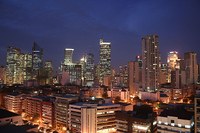 As Van Ginkel observes in an article appearing in the current issue of theTWAS Newsletter, in 2008, for the first time in history, more people were living in cities than in farms or rural villages.
As Van Ginkel observes in an article appearing in the current issue of theTWAS Newsletter, in 2008, for the first time in history, more people were living in cities than in farms or rural villages.
Global urbanization, he says, has occurred a breath-taking pace.
In 1900, less than 10% of the world's people lived in cities. That amounted to 160 million people. Today the world's urban population exceeds 3.4 billion people. As Van Ginkel explains, "It took tens of thousands of years for the majority of humankind to become agriculturalists and pastoralists. Yet, it took merely one century for the transition from rural to urban areas."
Van Ginkel notes that developing countries will be on the front lines of the urban revolution in the decades ahead. The urban population in Asia, for example, is expected to rise from 1.6 billion today to 2.4 billion by 2050. In Africa, it will increase threefold from 300 million to 900 million. The UN estimates that the total global population will climb from 6.8 billion to 9 billion over the next four decades and that virtually of all this growth will take place in cities in the developing world.
When it comes to critical issues related to sustainable development, Van Ginkel maintains that "cities are both a source of problem and a principal part of the solution."
On the one hand, urban residents are prodigious consumers. Consequently, as the developing world grows more prosperous, we can expect consumption levels to rise, especially in urban environments where people generally earn higher incomes. On the other hand, cities are places "where people live most efficiently – where, in effect, humanity's ecological footprints on a per capita basis tread most lightly."
"Less than 3% of the Earth's land mass is urbanized. Yet urban environments generate nearly 80% of he carbon emissions and account for 60% of the water consumption."
That's why Van Ginkel believes that "the future well-being of humanity resides in cities," particularly cities in the developing world that are growing at precedent rate. "Appropriate forms of urbanization that help ensure wise and sustainable land use patterns and efficient resource use and consumption," he concludes, "may be the last chance we have to create a more sustainable future."
To read the entire article, download the PDF (432 Kb).

